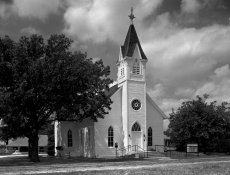I plan to burn a little film this coming weekend, and the subject matter will be many of the old wooden churches in central Texas. Now if the light is like today, gray and overcast, metering should not be as much a problem, but if it is bright and direct lighting I am curious how the folks here would handle the metering.
My first thought on a bright day, is to go with the Sunny f/16 and stop down 2 stops..when shooting what I call a micro landscape (a portion of the building) vs a macro landscape (one that would include the building and surrounding area). Then there would be filter factors if the sky is include and say a polarizer or red/yellow filter is added.
One of the churches I recall sitting in a grove of trees, so it will be deep shade, another sits on a hill with no shade at all. Still another I plan to shoot only the windows, the building is nothing special - but the windows seem to have a certain appeal.
Film will be FP4+ 120 roll film and 4x5, rated at 64 and I plan to develope it in Rodinal, 1:100 using a semi-stand development. Of course if mother nature does not help me out with good light then my plans will change.
Thanks in advance for your input.
My first thought on a bright day, is to go with the Sunny f/16 and stop down 2 stops..when shooting what I call a micro landscape (a portion of the building) vs a macro landscape (one that would include the building and surrounding area). Then there would be filter factors if the sky is include and say a polarizer or red/yellow filter is added.
One of the churches I recall sitting in a grove of trees, so it will be deep shade, another sits on a hill with no shade at all. Still another I plan to shoot only the windows, the building is nothing special - but the windows seem to have a certain appeal.
Film will be FP4+ 120 roll film and 4x5, rated at 64 and I plan to develope it in Rodinal, 1:100 using a semi-stand development. Of course if mother nature does not help me out with good light then my plans will change.
Thanks in advance for your input.





 In fact, do you not do this with the development? Would seem if you want to affect the change on the highlights N, N+, N- development is the way to do it - Right?
In fact, do you not do this with the development? Would seem if you want to affect the change on the highlights N, N+, N- development is the way to do it - Right? .
.
 haha Must be churches get the "sears" kit for standard white churches!
haha Must be churches get the "sears" kit for standard white churches!